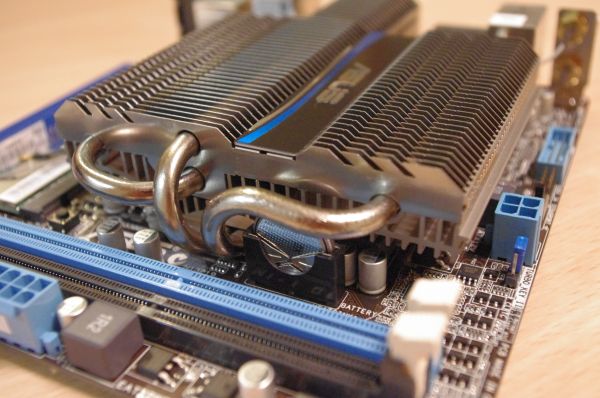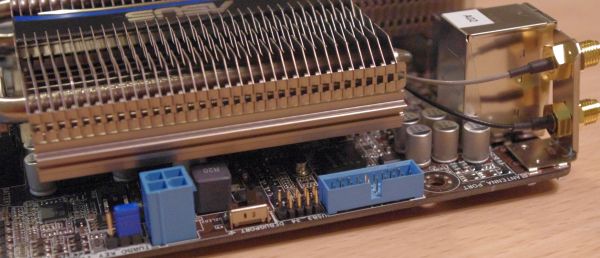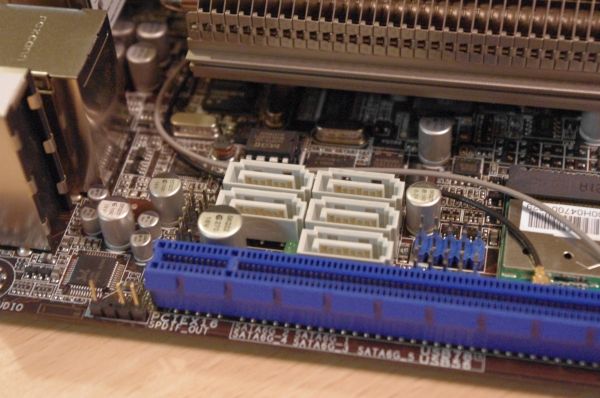Fusion E-350 Review: ASUS E35M1-I Deluxe, ECS HDC-I and Zotac FUSION350-A-E
by Ian Cutress on July 14, 2011 11:00 AM ESTEver since I first tinkered around with the ASUS board, I had a love/hate relationship with it. It's a prime example of what a lot of people may want in a board - it's passive, the wifi is already built in (you just fix the antenna), and it runs straight out of the box. But the more I prodded around the vibrant exterior, I tried to find what I would get for my $175, especially compared to the other boards I have here for review.
Despite the E-350 processor on board, the passive heatsink gets incredibly hot to touch, even at idle in a fanless environment. The CPU itself is rated at 18W, and without a discrete GPU, the board is pulling around 60W in our stringent tests. This is disconcerting, considering that the ECS board (even though it isn't passive) pulls off a 33% overclock. Also, due to the size passive heatsink, the IO panel is hit - the onboard audio has only two outputs and we're limited to DVI and HDMI video. This doesn't happen on the Zotac board, which is also passive.
Visual Inspection
I've mentioned it before and I'll mention it again - heatsink. This motherboard has a massive one, with ASUS on it, just in case you forgot. The heatsink is still shorter than any full height DDR3 memory you put in the DIMM slots, and there are two fan headers found in the top left, just beside the heatsink in that corner.
There is a USB 3.0 header along the top of the board, along with a debug header, a Turbo switch, a 4-pin 12 V CPU connector and the Clear CMOS header. Unfortunately, the writing next to these is all mixed up - the writing above the turbo switch says 'DEBUG PORT' and above the Clear CMOS is 'TURBO_KEY+II'. Nowhere on the board does it say the Clear CMOS is the Clear CMOS - during bad overclocking I had to refer to the manual to find this information.
Thankfully, the front panel connectors are still on the right hand side of the DDR3 DIMM slots (unlike the ECS), and the wifi card is preinstalled in a very tight space the other side of the DIMMs. The five SATA 6 Gbps ports are also here, with USB 2.0 headers, and the MEM OK button which is ASUS' memory adaptation feature if there is incompatibility with any memory module changes. The HD Audio header is on the far left of these headers and ports, which could cause an issue depending on where the cable is coming from and what's installed on the board. There is also a full length PCIe slot - it will accept any 16x peripheral, but run it at 4x speeds, including discrete GPUs.
The I/O panel is a mixture of positive and negative. Because of the large heatsink impinging into the panel, some of the functionality is lost. Alongside the two antenna ports, we have a single PS/2 port, four USB 2.0 ports, two USB 3.0 ports, HDMI (1.3b) and DVI video outputs, optical S/PDIF Out, a Bluetooth receiver, an eSATA 6 Gbps port, an Ethernet port and three audio jacks. The big surprise here is that the HDMI is only 1.3b and not 1.4a...




















67 Comments
View All Comments
CZroe - Saturday, July 16, 2011 - link
Regarding the Asus board not having HDMI1.4, you never seem to confirm that the others do or don't. have it. Should I assume they do or don't?"...and a Wifi card with a pair of antenna"
Antennae is the plural of "antenna." ;)
You wonder about the VGA reference in the Asus board's BIOS, but other boards clearly include a DVI to VGA adapter. Even if the Asus board doesn't include it, it could be referring to that unless it is DVI-D only. Does it support a VGA adapter?
"how overclocking effects gaming"
"Effects" should be affects.
Akdor 1154 - Saturday, July 16, 2011 - link
Given these boards are clearly pushed at the HTPC usage scenario (HDMI, TOSLINK optical outputs, one of the most powerful onboard GPUs ever made, passive cooling, etc) it is very disappointing to not see any of this functionality tested out.How did they perform decoding video? Given the high CPU usage on network utilization, is there any issue playing high bitrate content from a NAS somewhere else? Can I encode? How did the GPU perform on OpenCL tasks (namely, again, content encoding)? Can the PCI-E slot take a TV tuner? What about Flash, if only for Youtube? How about upscaling low-resolution content?
And for the love of God, given two passive and one active cooling setups, how did they fare in a REAL case? Don't know many people who run their HTPCs in open-air, and the nice small cases available can be quite restrictive in terms of airflow - so will the passively cooled boards even be suitable for these? How about fan noise? It would seem Zotac and ASUS went passive because of noise concerns, so how bad was the ECS's little 40mm fan?
What about WiFi performance? You complained about one only supporting HDMI 1.3b; did the others support 1.4 (and hence 3D) perfectly? Did you test this? There was an issue with Windows' audio buffer latency - it would have been great to see this actually tested out to see if it made any difference, instead of a vague "some people might be able to hear it". Did the problematic board skip at all?
Summing up the lack of insight in the way this review was carried out.. <b>did you even test Blu-Ray playback</b>?
I'd love to see this information added to this review - I'd also be interested to know how many people you think would purchase this intending to run Metro 2033 on it.
And finally it seems your comment form is broken in Opera.
evolucion8 - Sunday, July 17, 2011 - link
And the odd thing is when they were testing its IGP performance with Metro 2033, calling it "the Crysis of DX11 until Crysis 2 arrives, so Crysis 2 haven't been released yet? Mishmash of old and new sentences of old articles glued together. Pretty much the same thing that apoppin does on Allienbabletech and his horrible lack of focus and handbacked marketing propagandism.Plus the fact that the review has a lack of objectivity as it isnt compared to its direct rival the Atom/ION combination. I wonder who will stick a GTX 580, play games or will use it for WinRaR archiving. Atom and Fusion aren't powerhouses, are CPU's for very basic stuff and HTPC and they would had done tests in that arena, like web browsing tests, movie playback, Flash tests, USB and HD performance etc. Totally irrelevant, how low can this go?! Definitively one of the worst reviews I've ever seen.
Overall, a HTPC oriented system tested with unconventional tests against much more expensive and powerful solutions. It is like taking a Ferrari and test its performance under water and in outerspace and comparing it against the Columbia Shuttle and Navy's Nuclear Submarine. Things had gone under spiral lately and integrity has been long gone in here, a pity.
PR3ACH3R - Sunday, July 17, 2011 - link
@ Ian CutressThanks for the review,
I think you touched upon a few important points like thermal performance, but as a whole, this review leaves a lot to be desired.
it is incomplete, & fails to address what the target audience of these products, wants to know.
Did this review help me decide what board to buy for HTPC use?
I'm afraid not.
Ichinisan - Sunday, July 31, 2011 - link
It's pretty clear why the Asus BIOS mentions "VGA." The Asus and Zotac boards have DVI-I connectors, so they have extra pins for analog and work with a VGA adapters.dakky21 - Saturday, November 5, 2011 - link
I registered on this board just to say that... not ALL boards have overclock function !!!!I just bought HDC-I v1.0 yesterday, in fact only because I read it had overclock option, but what a cold shower - it does not have. At least not where it should be, under Frequency/Voltage control in BIOS.
dakky21 - Sunday, November 6, 2011 - link
To clarify, my board has BIOS version 2.10.1208 (03/24/2011) and there is NO Turbo Mode in Frequency/Voltage control. No way of getting around 33% more speed. Unfortunately, I bought this board just because of that. Never again trust reviewers or ECS...